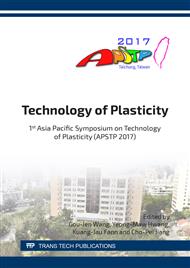p.3
p.10
p.16
p.22
p.28
p.34
p.40
p.46
Experimental and Numerical Analysis of Titanium Alloy Microtube Tube-End Nosing Forming
Abstract:
This study is mainly based on five sets of mold cone angle and friction coefficient of micro-tube tube end necking forming analysis, and the tool cone angle of 60° experimental verification is carried out to analyze the titanium alloy (Grade 1) micro-tube for different mold cone angle and the different friction coefficient caused by the difference between the shrinkage forming. In this paper, Prandtl-Reuss's plastic flow rule, combined with finite element deformation theory and updated Lagrangian formulation (ULF) concept, establish an incremental elasto-plastic finite element analysis program for simulating the miniature tube end necking. The forming process also uses the generalized rmin algorithm to deal with elasto-plastic state and contact problems. From the simulation data of necking process, deformation history, punch load and punch stroke, stress and strain distribution is obtained. The analysis results show that by increasing the mold cone angle and friction coefficient, the thickness tends to be thicker in the certain area.
Info:
Periodical:
Pages:
16-21
Citation:
Online since:
April 2018
Authors:
Keywords:
Price:
Сopyright:
© 2018 Trans Tech Publications Ltd. All Rights Reserved
Share:
Citation:


